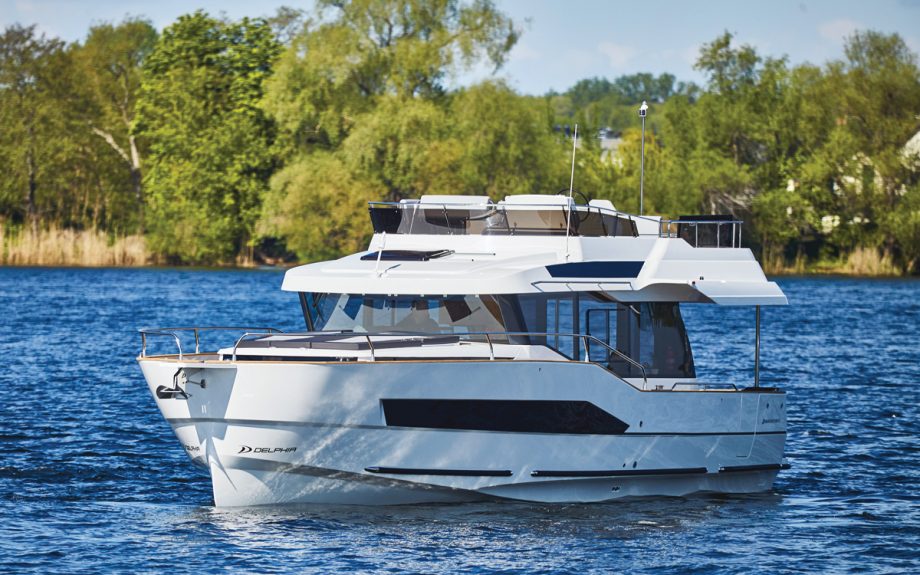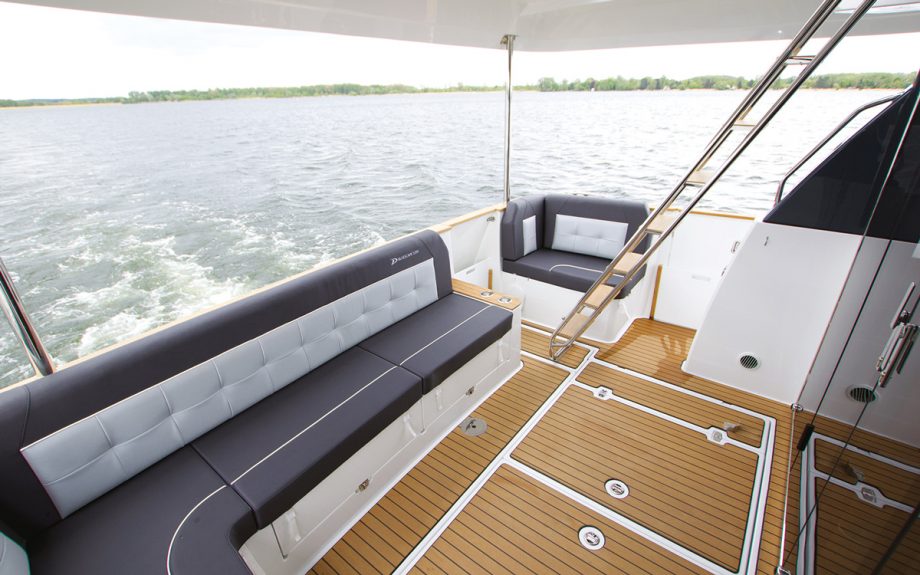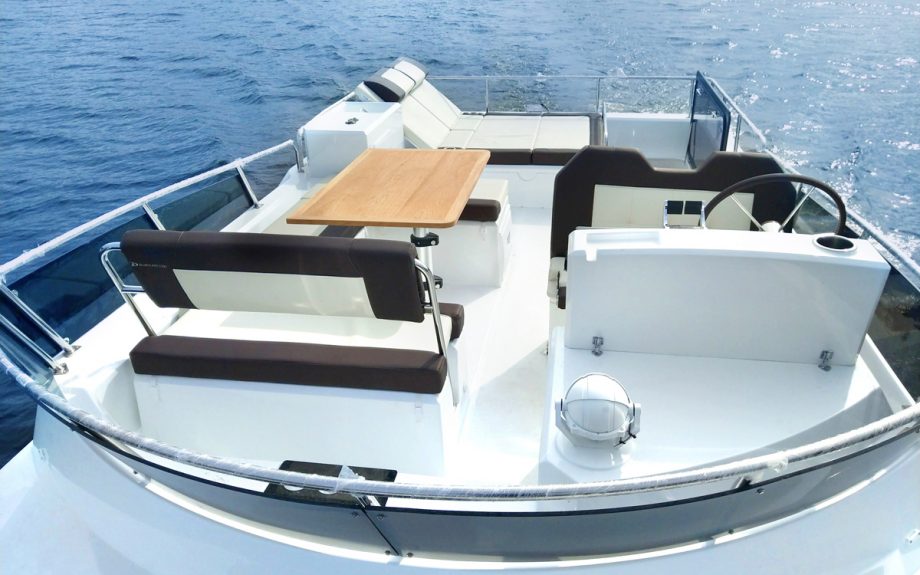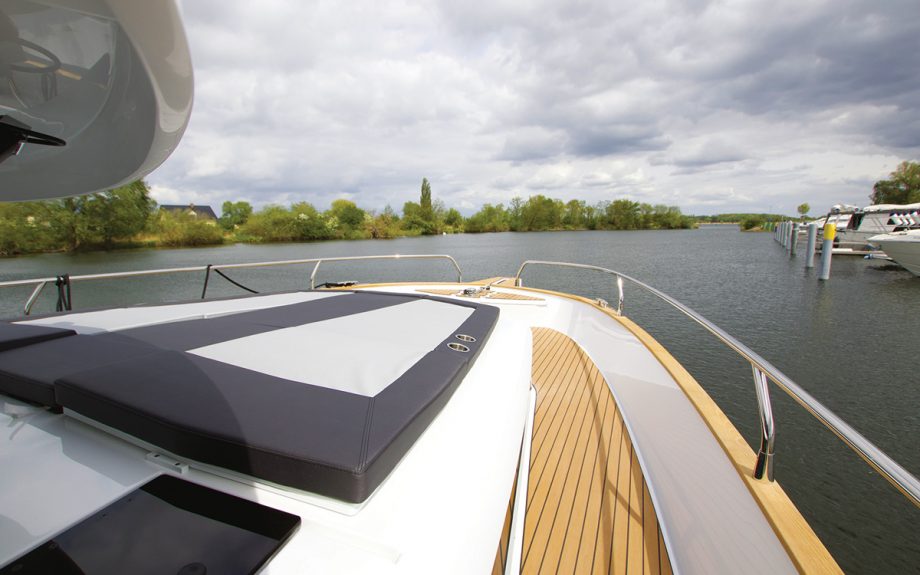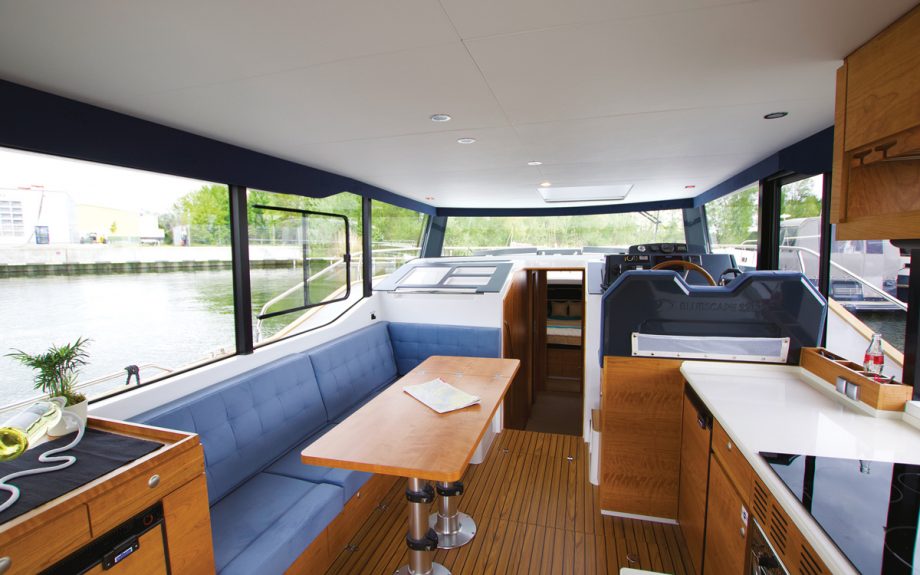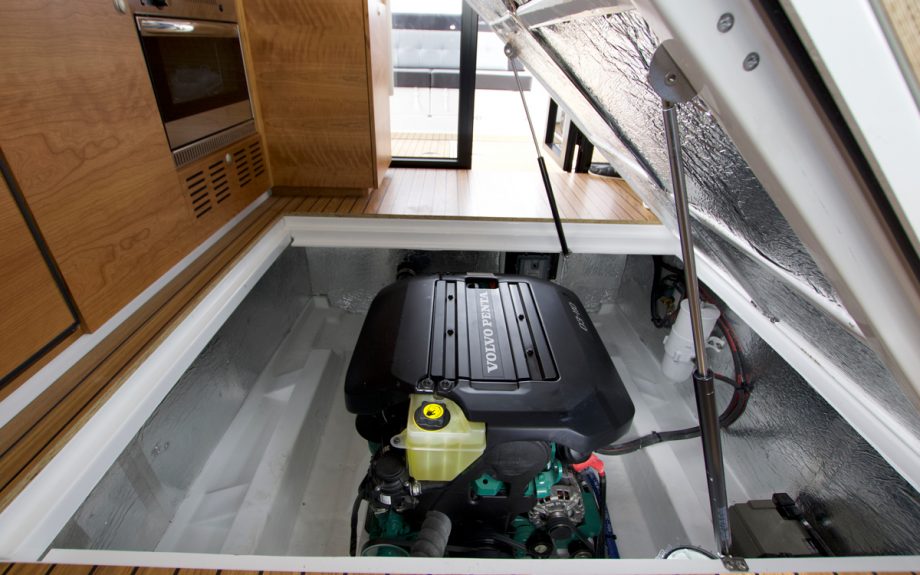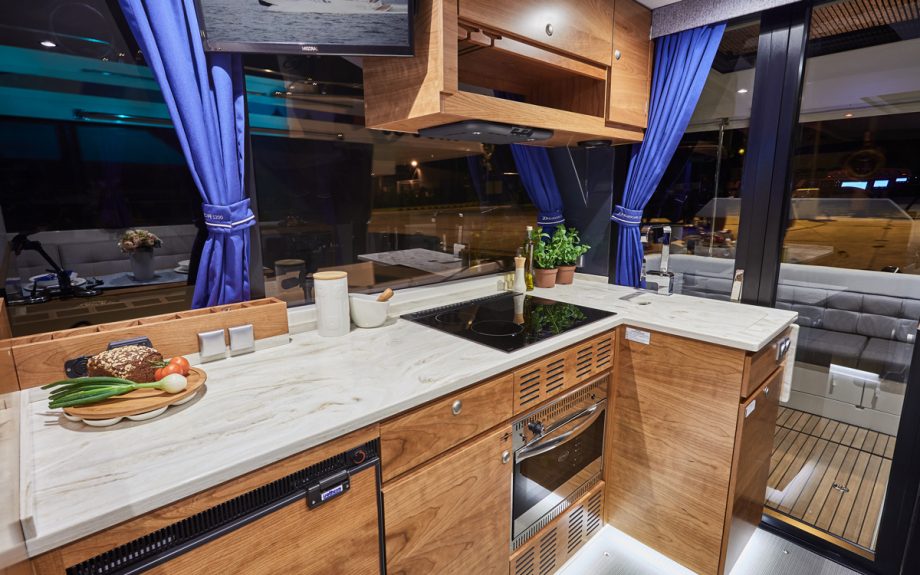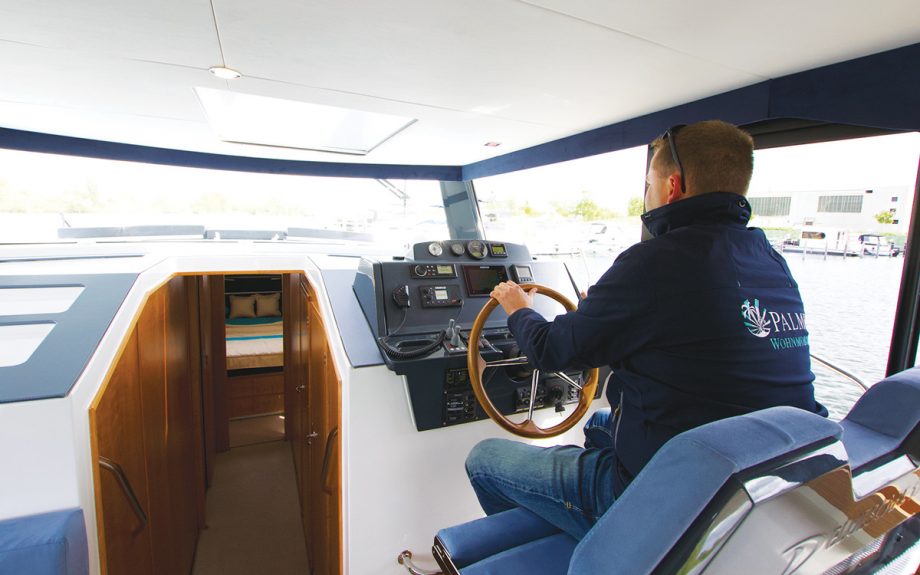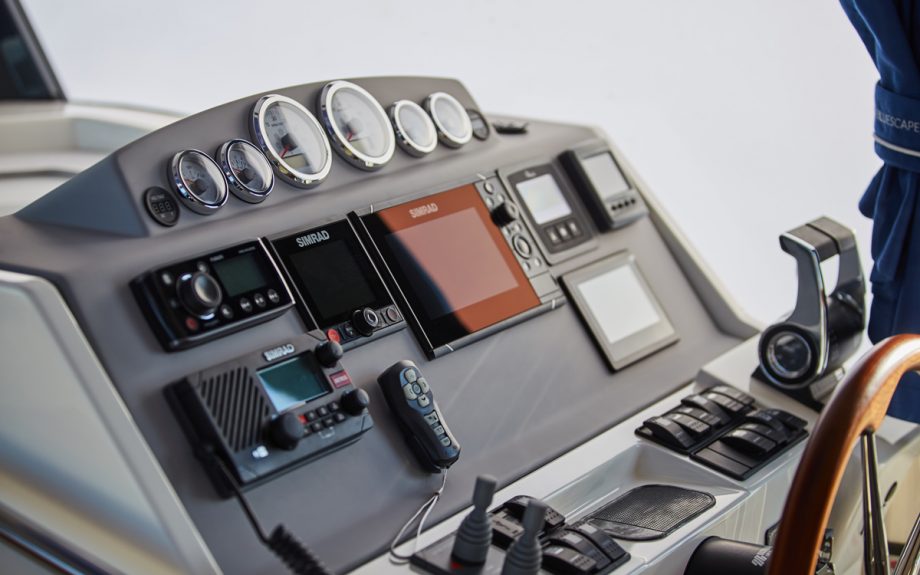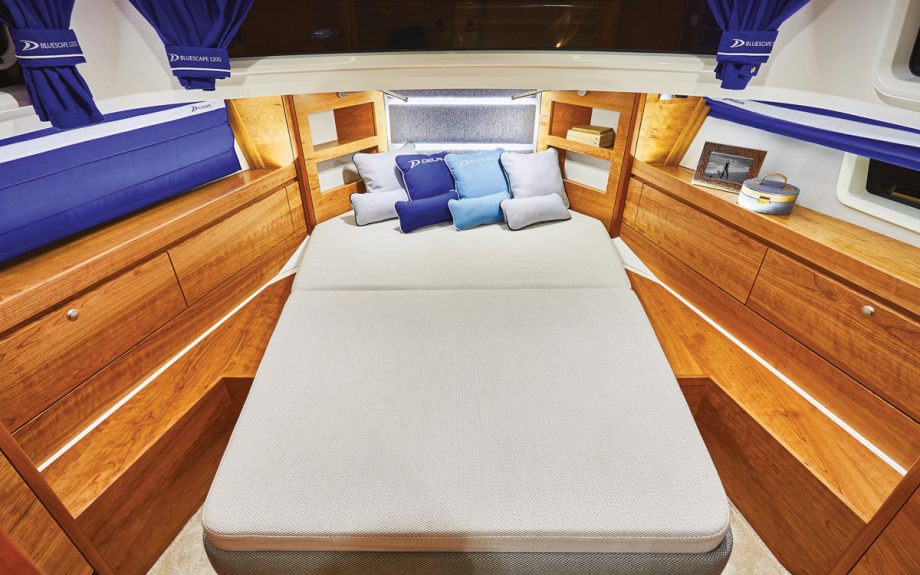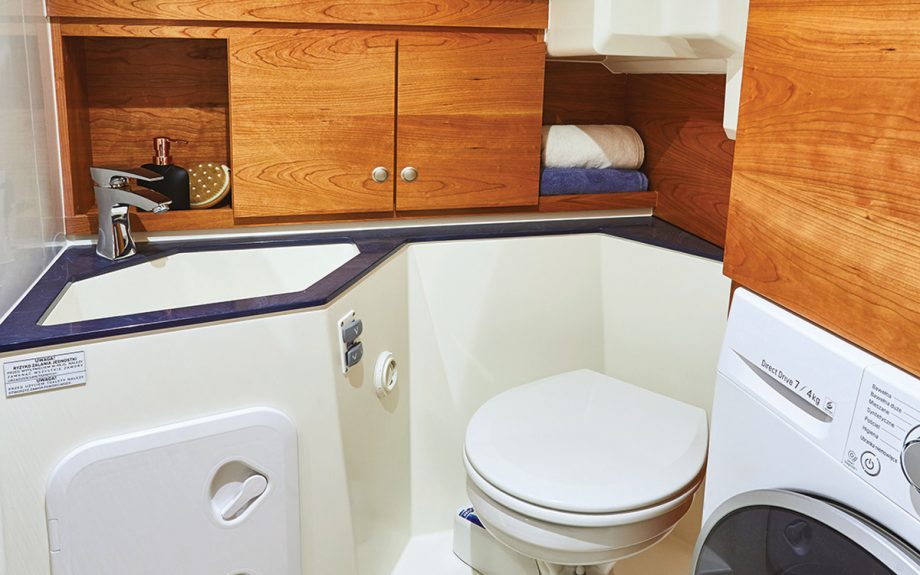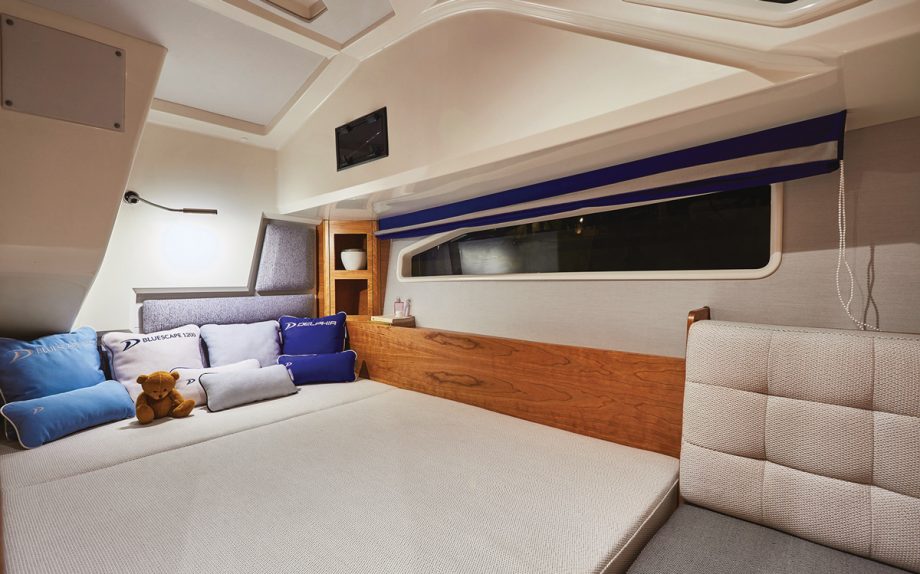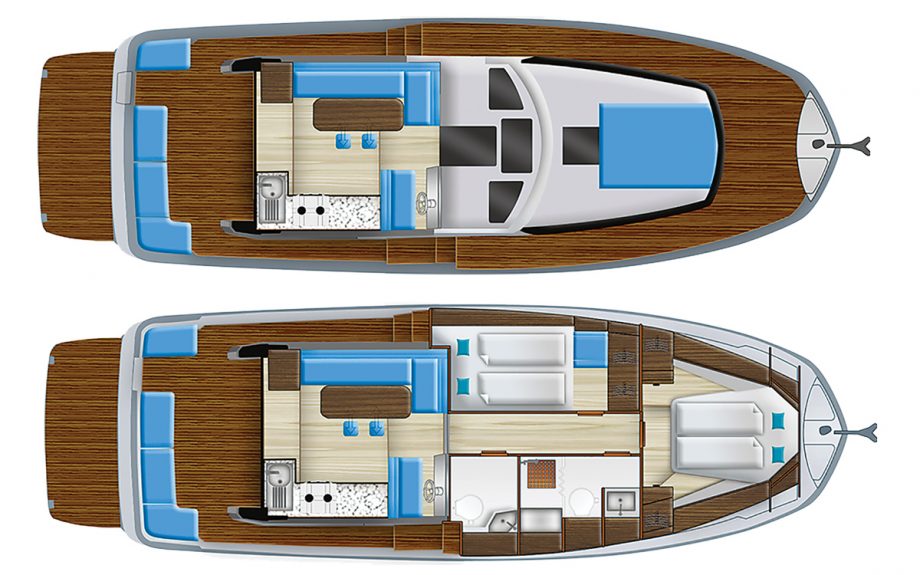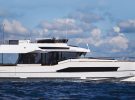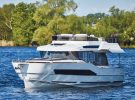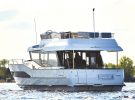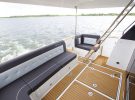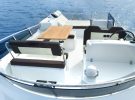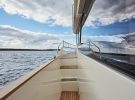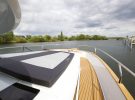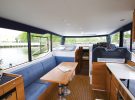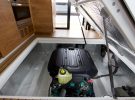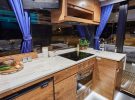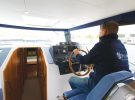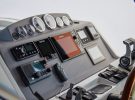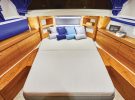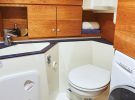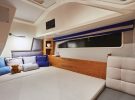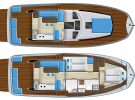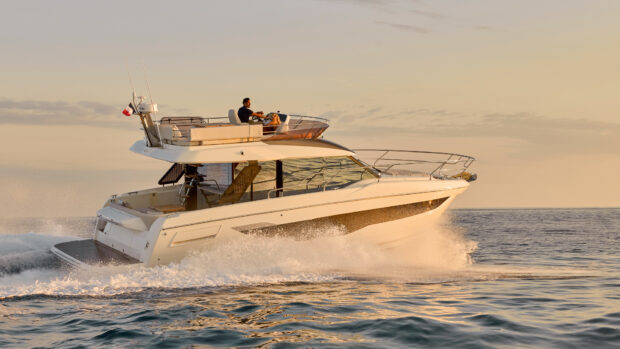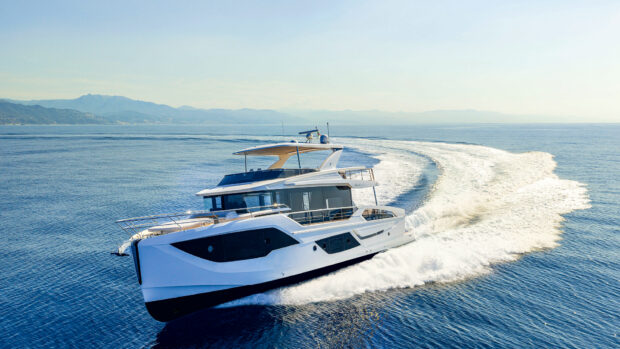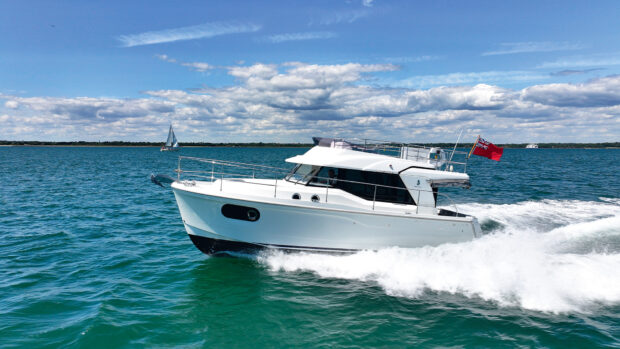The first flybridge to surface from Delphia’s yard looks like a remarkable amount of boat for the money. Alex Smith jumps on board to see if it lives up to its promise
Launched in 1990 by Polish brothers, Piotr and Wojciech Kot, and now part of the large Beneteau Group, Delphia Yachts has developed into a boat builder of serious international repute. Headquartered in Warsaw with manufacturing facilities in Olecko, the company builds a fleet of seven motor boats from 26 to 42 feet with a focus on clean lines, good deck spaces, modern interiors and exceptional value for money. It used to build sail boats too until Beneteau decided it should concentrate solely on power.
Although it has been building boats for 30 years, the BluEscape 1200 Fly is the first flybridge model to emerge from the yard. Designed in conjunction with Tony Castro and sharing its hull with the award-winning 1200, this second of Delphia’s BluEscape cruisers takes the template laid down by the original 1200 hard top model and introduces an upper deck for those less concerned with air draft restrictions on inland cruising routes and more concerned with external lounging and entertaining space.
Perversely though, the BlueEscape 1200 Fly model actually seems better proportioned than the original 1200, which is so rigorous in its pursuit of a bridge-friendly air draft (it can access the entire European canal network) that it looks a touch scalped. True, from some angles (notably head on and from either quarter) the new Fly model does look a bit slab-sided but from side-on there’s more than a whiff of the trawler-style adventure yacht about it.
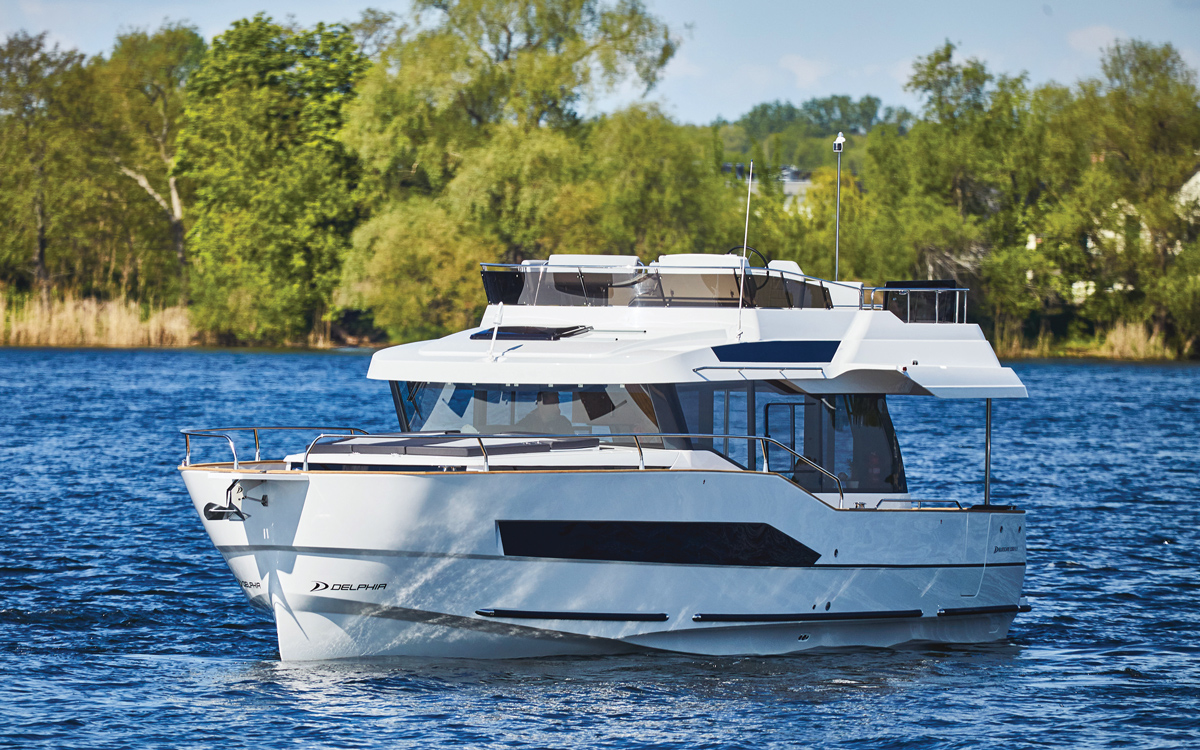
Internal layout
Delphia has become well known for the easy flow of its day spaces and the saloon of the BlueEscape 1200 Fly bears that out. Although the demands of the unsually wide side decks limit the footprint to little more than eight square metres, the use of a long starboard galley opposite a port dinette with foldout stools keeps the central walkway clear.
The provision of a side door next to the helm also takes the pressure off the primary traffic zone, while headroom of 6ft 6in throughout and tall windows that flood the space with natural light make the most of the space. The forward sunroof is rather small and deepset but there’s no shortage of ventilation and no sense that the fly deck’s arrival has impoverished the calibre of the saloon’s living environment.
The companionway next to the helm takes you down to a lofty central corridor and on to the master cabin in the bow. Here, in addition to easy standing headroom for a six-footer, you get a large diamond-shaped bed measuring 5ft across (1.52m) at the shoulders. This unusual shape ensures there is plenty of room to walk up and down either side and leaves space for a couple of seats, enabling you to sit down and change.
Article continues below…

Bavaria R40 review
Fast and fuel efficient, thanks to the space saving benefits of sterndrives the Bavaria R40 packs a lot into 40
£400000

Galeon 420 Fly review
The Galeon 420 Fly offers a huge amount of customisation - including the choice between shafts, sterndrives and IPS pods
£417686
Storage here is also very good. There are two deep wardrobes plus a scattering of useful shelves and drawers. There’s also a huge, lined storage space under the bed accessed by a vented ply hatch that lifts on gas-assisted rams. And thanks to a two-part mattress, which folds as the panel lifts, you don’t need to remake the bed every time you use it.
However, the most pleasant surprise in the owner’s cabin is the amount of natural light. It’s extremely bright in here, with no fewer than seven different sources – two ports in the hull sides, two skylights overhead and a further three vertical wraparound windows built into the elevated deck moulding, giving great light as well as excellent 180° views over the foredeck gunwales.
This focus on natural light is echoed in the guest cabin to port, where the four windows in the hull side and superstructure are supplemented by opaque overhead panels that let light filter down through the dash panel from the windscreen above.

The double bed occupies the full width of the guest cabin
The guest cabin feels very well appointed in other ways too. It comes with a big shelf space on top of the forward storage unit, a comfy seat at the foot of the bed, 6ft 4in headroom and a bed much the same size as a regular household double.
Like the main cabin, it also features a huge under-bed space with a similarly user-friendly means of access – and while a six-footer has to stoop a touch to get through the door, in all other regards, it could easily cater for adult guests on an extended cruise.
The standard layout has two heads compartments next to each other: a small day heads with a washing machine, and a larger shared bathroom with a shower. Rather sensibly, the test boat’s optional arrangement splits that into three rooms, with a separate shower compartment bookended by a private ensuite heads for the master cabin and a day heads further aft.

The day heads also has room for a built-in washer dryer
In all cases, headroom is excellent and, even with the optional layout, there is still a great deal of room. The ensuite in particular offers generous space for the toilet and sink, with a cleverly recessed towel rail and plenty of natural light, courtesy of three windows.
Deck spaces
In terms of build and finish, it’s interesting to note that the Delphia yard undertakes all its own lamination, joinery and assembly. The benefits are striking. The designers have used a consistent palette of light woods and brushed metal fittings, allied to modern blinds and neatly concealed LED strips that generate an ambient glow rather than spots of light and dark.
When you delve behind the scenes, all ply and fibreglass edges have been rubbed to a smooth finger-friendly finish and sturdy through-bolting seems to be standard practice rather than a sporadic luxury. If I were being ultra-picky, I would still like to see timber plugs rather than beige plastic caps tidying up the various countersunk screw holes, but there’s no doubt that the finish feels at least a grade above its price bracket.

Delphia is well known for the easy flow of its day spaces; the saloon of the 1200 Fly bears that out
Step outside into the aft cockpit and you are greeted by a huge bench seat, which spans the entire 3.4-metre width, breaking only to create a port-side entrance from the swim platform. Storage here is impressive, particularly beneath the deck hatch; and access to the side decks is equally good, even with the fly ladder locked in the ‘active’ position.
When not in use, the metal bracket to secure the ladder stands a couple of inches proud of the deck, creating a small trip hazard, but freedom of movement along the side decks, up the three steps to the elevated foredeck and around the sunpad is otherwise exemplary.
Up top, the fly deck has a two-man helm to port, opposite a C-shaped dinette with a reversible forward bench, a large sunpad aft and a starboard wet bar between the two. It also comes with cushions, which are slim enough to be stowed beneath the sunbed’s ram-assisted lid.
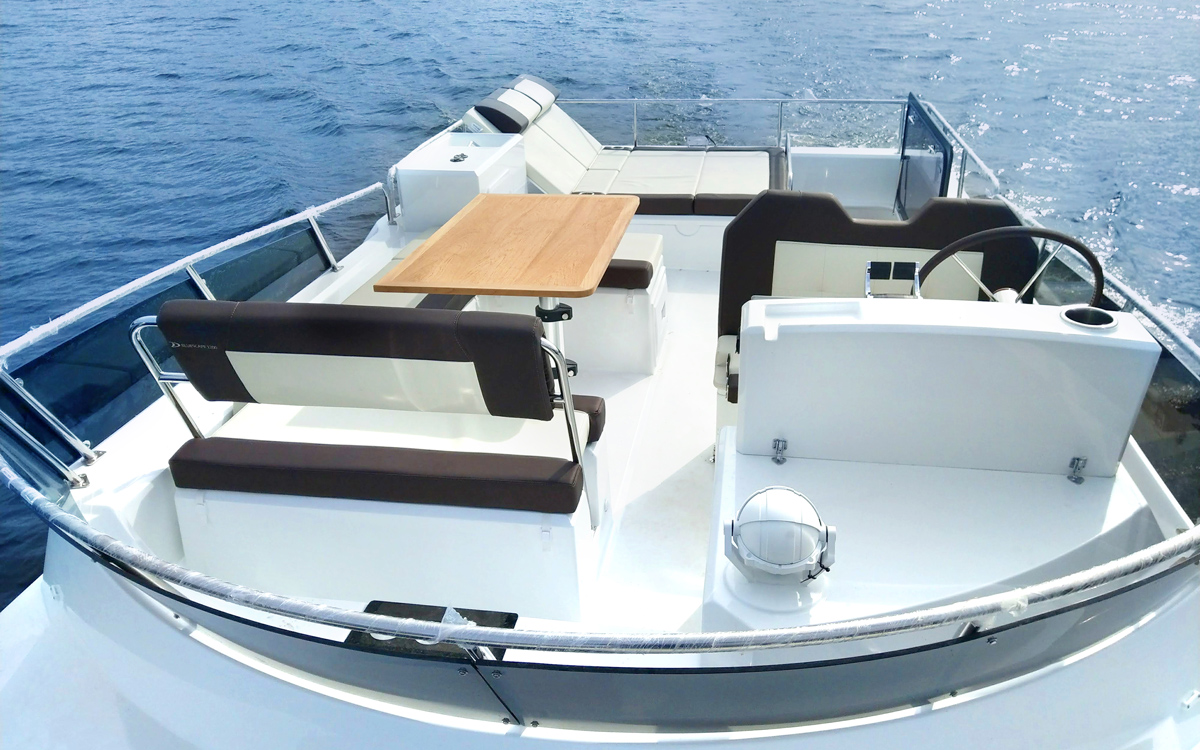
That’s a very thoughtful touch and yet, as the newest element of the boat, the flybridge does exhibit a few uncharacteristic areas of imperfection. For instance, the helm seat has a hinged upper section, enabling you to use the internal space for storage but, compared to the rest of the boat, the mouldings feel a bit crude.
Similarly, while it makes good sense that the helm console can be swung open, providing access to the backs of the instruments, the over-tight routing of the wires means they restrict the travel of the hinged upper moulding. But given the consistency exhibited elsewhere, not least in the wonderful ‘small ship’ fastidiousness of the wiring arrangements, these issues are unlikely to be repeated on subsequent models.
From the helm
Despite the fact that it’s a blustery day, with winds gusting to Force 4, it’s immediately plain that both directional stability and manoeuvrability are very reassuring on the BlueEscape 1200 Fly. Whether at half a knot in the confines of the marina or at 8 knots out at sea, the 1200’s long keel, twin (optional) thrusters, helm side door and upper helm make this a very easy boat to drive.
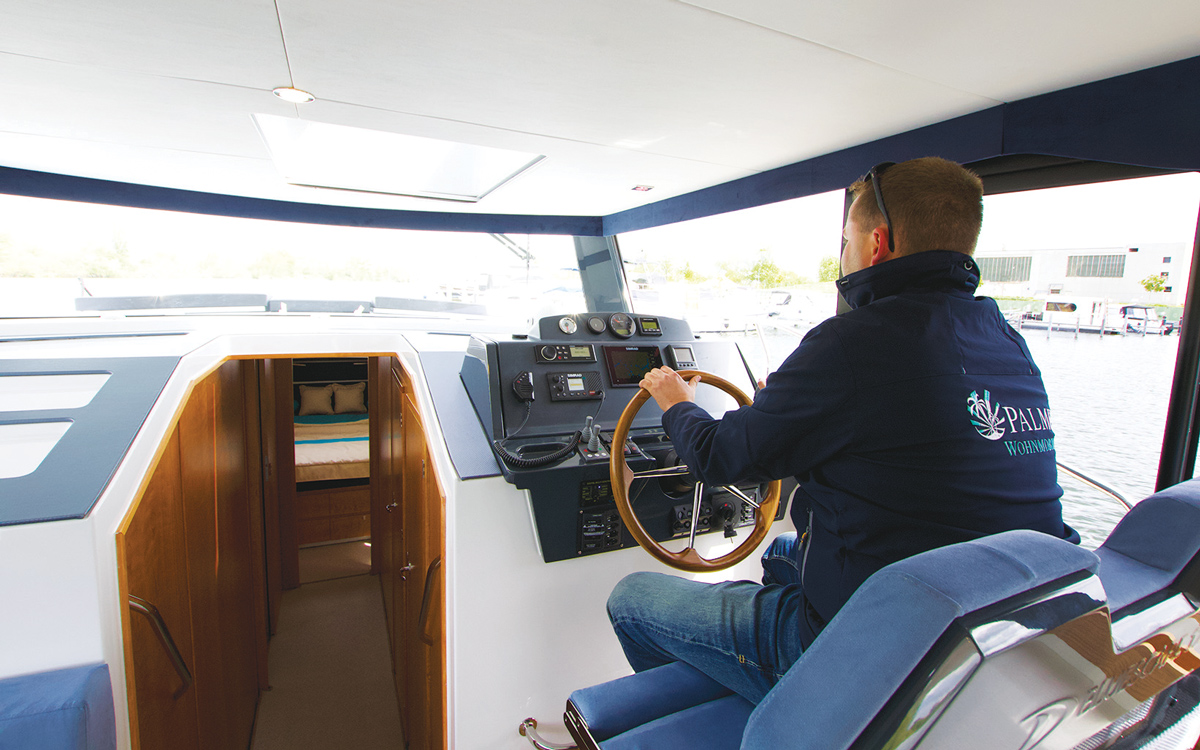
Reverse-angled screen gives clear glare-free visibility
However, as a displacement cruiser, designed to prioritise comfort and economy, the engine choice is an interesting one. You can spec either Nanni N4 115hp or 140hp engines in single or twin configurations; or a Volvo Penta D3 110hp or 220hp in single configuration only. That brings speeds well in excess of 10 knots into play but, if you don’t feel the need to rush, there’s plenty to be said for the modest engine option of the test boat.
Rigged with the single Volvo 110hp D3, our figures show a fuel flow of just two litres per hour at 5 knots, increasing to 17 litres per hour at 9 knots. That’s an 850% increase in fuel consumption for an 80% increase in speed, so it’s plain that keeping things reined in pays big dividends – but you don’t have to rein them in too much.
If you sit just a couple of knots off the test boat’s 8.9-knot top end, you can still keep fuel consumption below one litre per nautical mile, enabling you to eke out a range of around 170 nautical miles (with a 20% safety margin) from the standard 200-litre fuel tank.

The BluEscape1200 is a very self-assured piece of work
For those in search of refinement as well as economy, it’s worth noting that there is a minor peak in noise at 6 knots when, with the engine spinning at 1,750rpm, some extra reverberation causes the decibels to spike at 62 before settling back down to 58.
That anomaly aside, the readings remain usefully below 60 decibels at everything under 7 knots, making the BlueEscape 1200 Fly a boat that can be comfortably (if not quickly) cruised on passages of up to 350 nautical miles, should you fancy being off-grid for a week at a time. And if long-distance cruising really is a major priority, it’s good to know that the standard fuel tank can be upgraded to 300 litres.
Price as reviewed:
£353,165.00 inc. VAT
Verdict
The 1200 Fly is a very self-assured piece of work. It comes with outstanding storage, extraordinary reserves of headroom, great light down below, excellent refinement underway and, for the most part, a very impressive level of finish. The fact that it adds another deck’s worth of day space to the award-winning 1200 while actually improving the aesthetics also makes it much more appealing to coastal boaters. Admittedly, the displacement only hull won’t work for everyone but don’t mistake that for meaning it’s unsuitable for sea passages. It’s Category B RCD rating is the same as most planing 40-footers, while the option of twin engines gives added redundancy and the power to punch tides. Above all the BluEscape 1200 Fly gives people the chance to buy into a stylish, spacious 40ft flybridge boat for well under £350,000.
Details
Starting price : €268,206 (inc. VAT)
LOA: 41ft 10in (12.75m)
Beam: 14ft 0in (4.26m)
Displacement (provisional) : 8.78 tonnes (19,357 lbs)
Fuel capacity : 200 litres (44 gal)
Engine options : Single or twin 110–220hp
Test engine : 110hp Volvo Penta D3
Top speed on test : 8.9 knots
Cruising speed : 6.6 knots
Fuel consumption at 6.6 knots : 5.5lph
Cruising range : 172 miles
Noise : 58dB(A)



